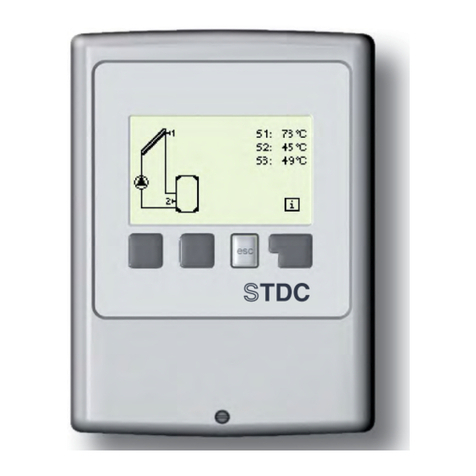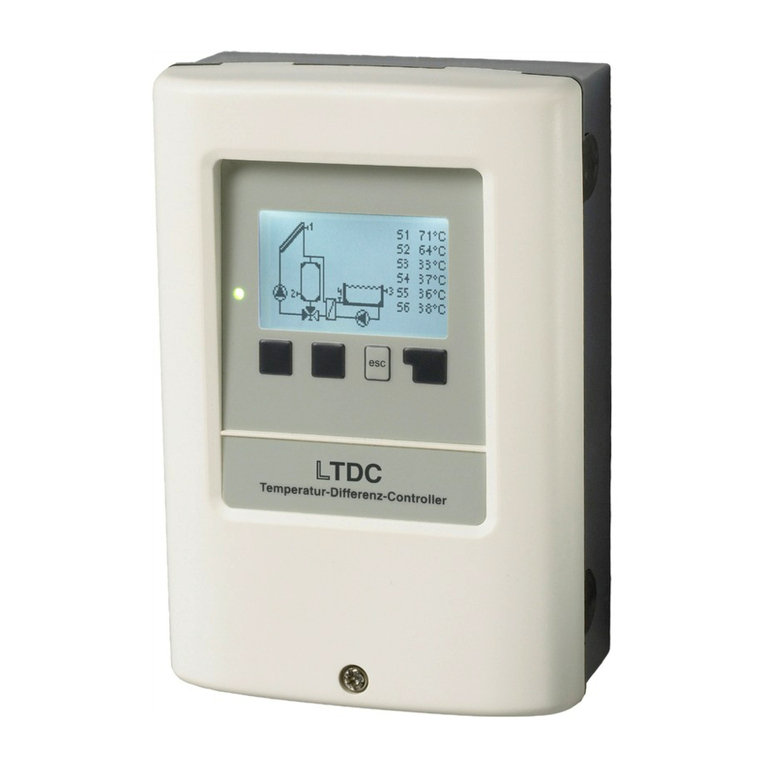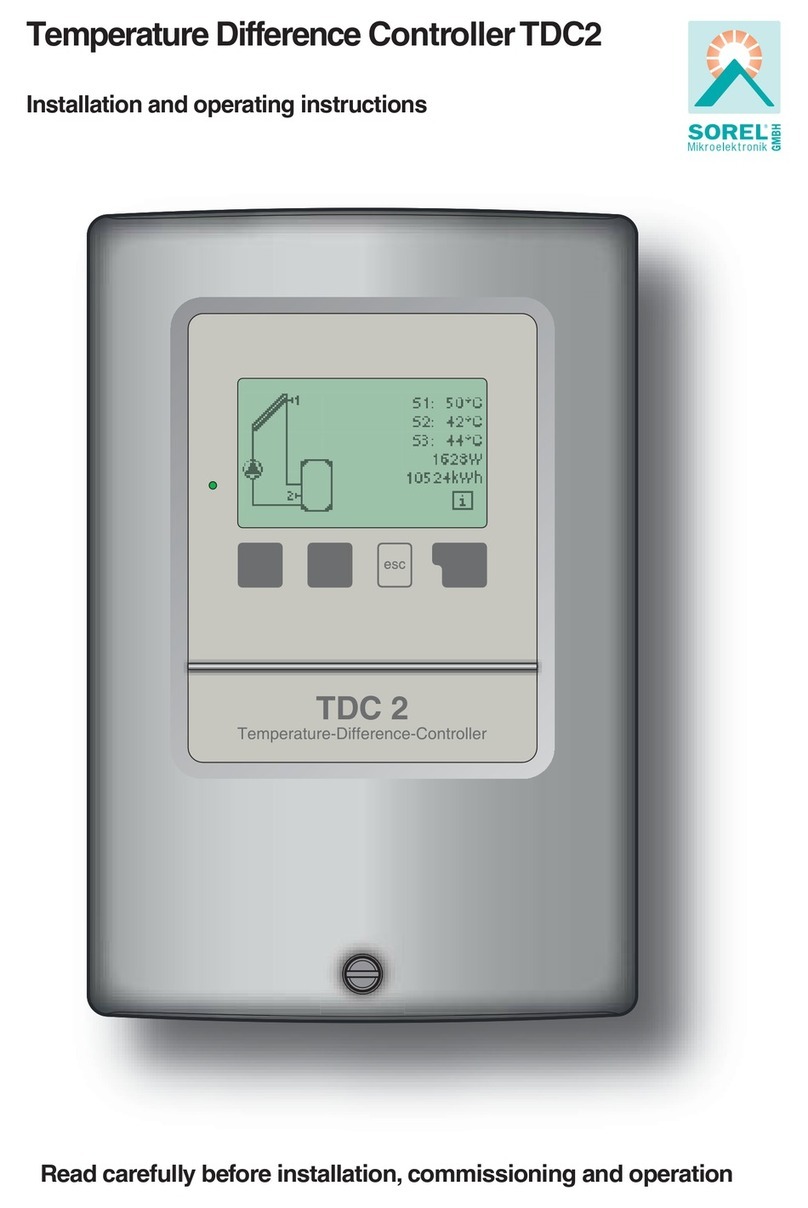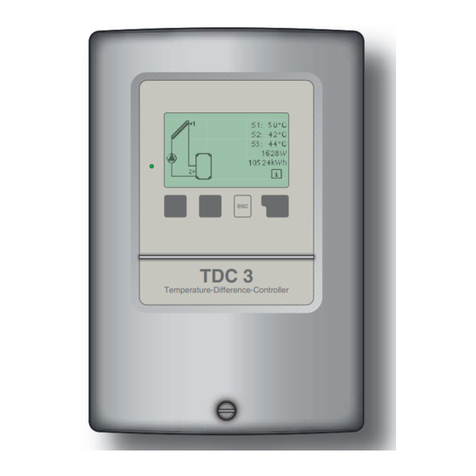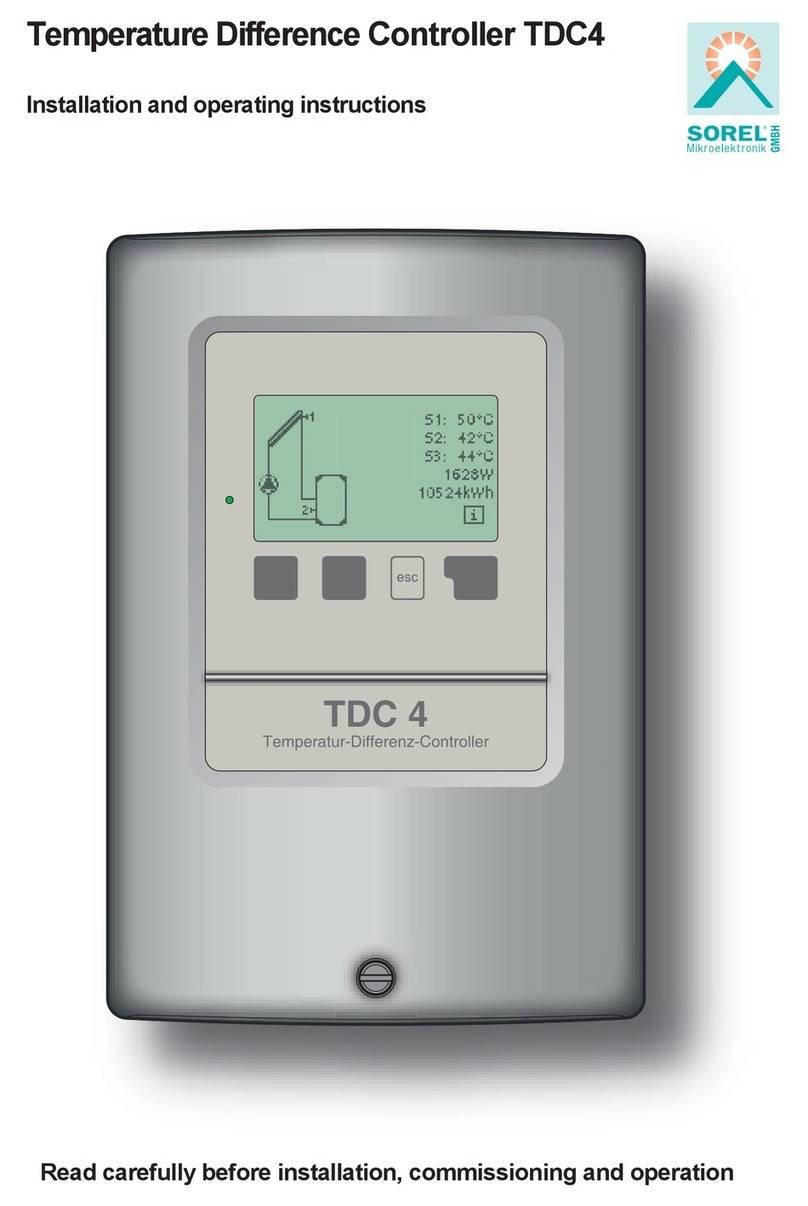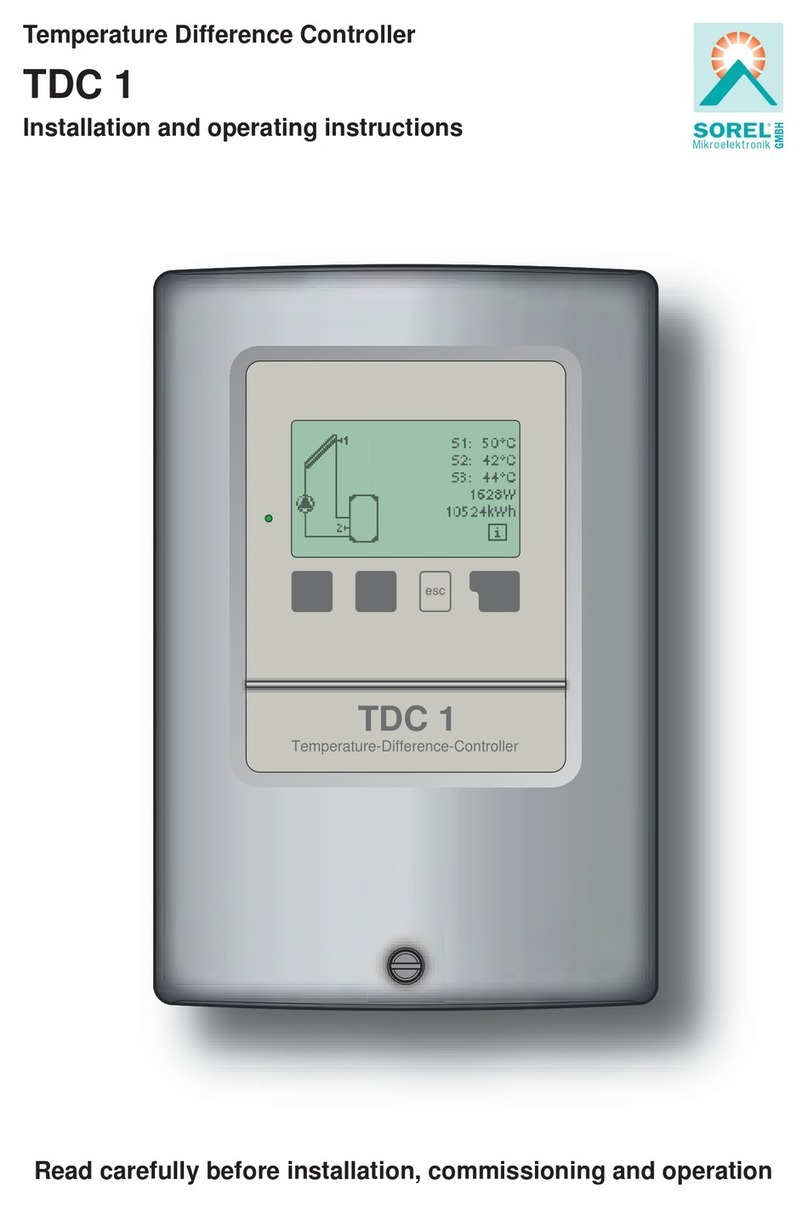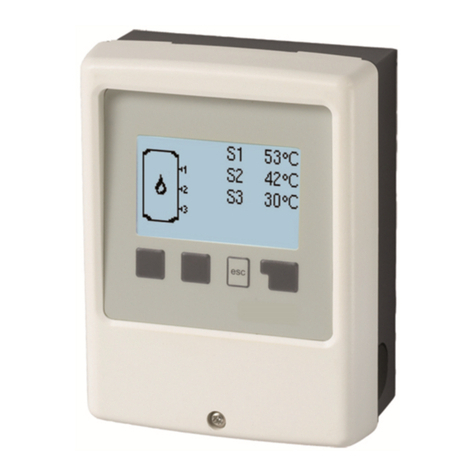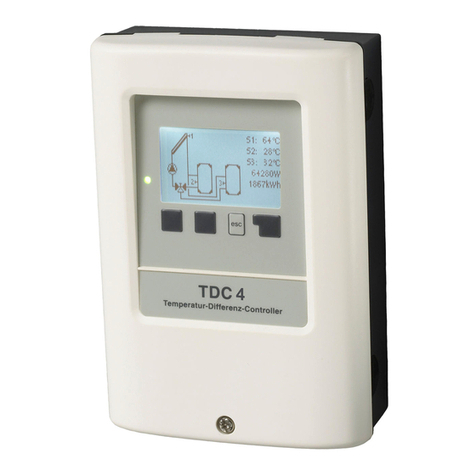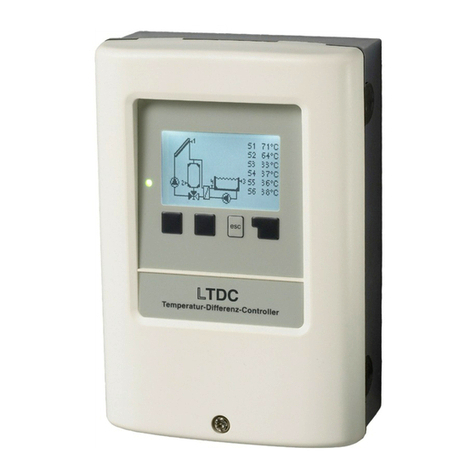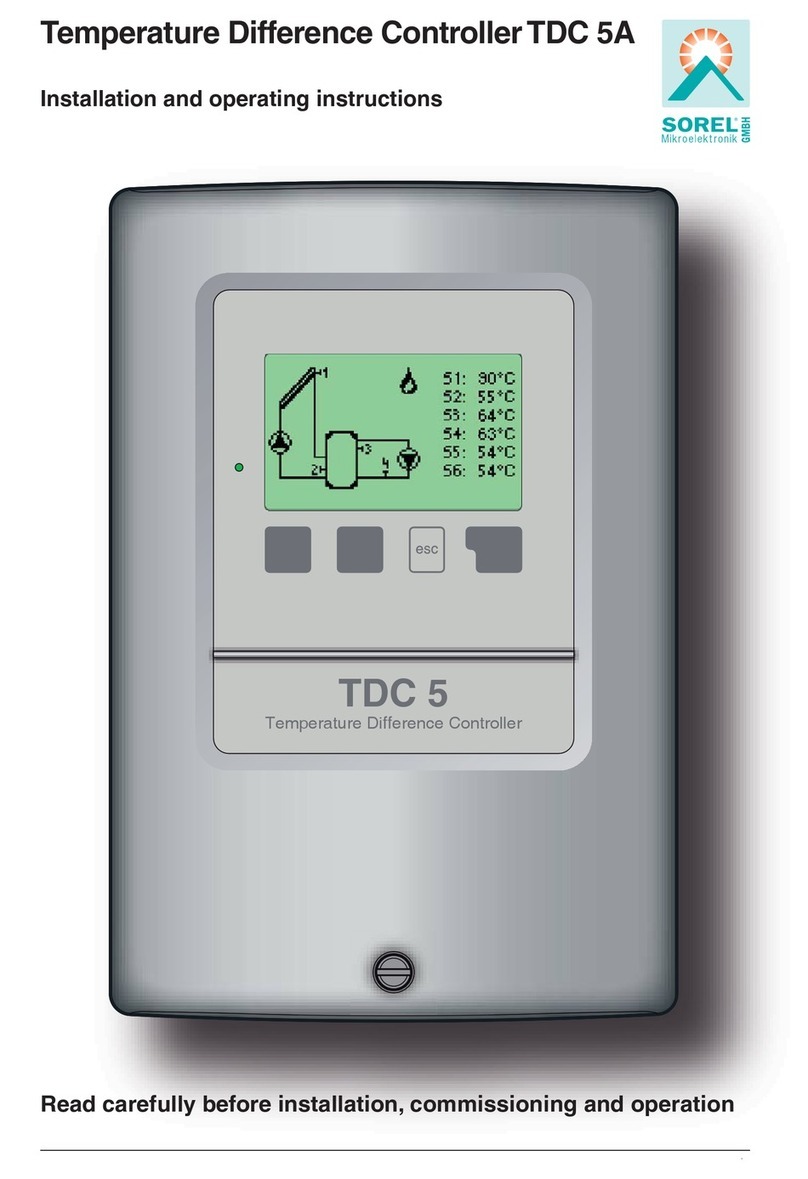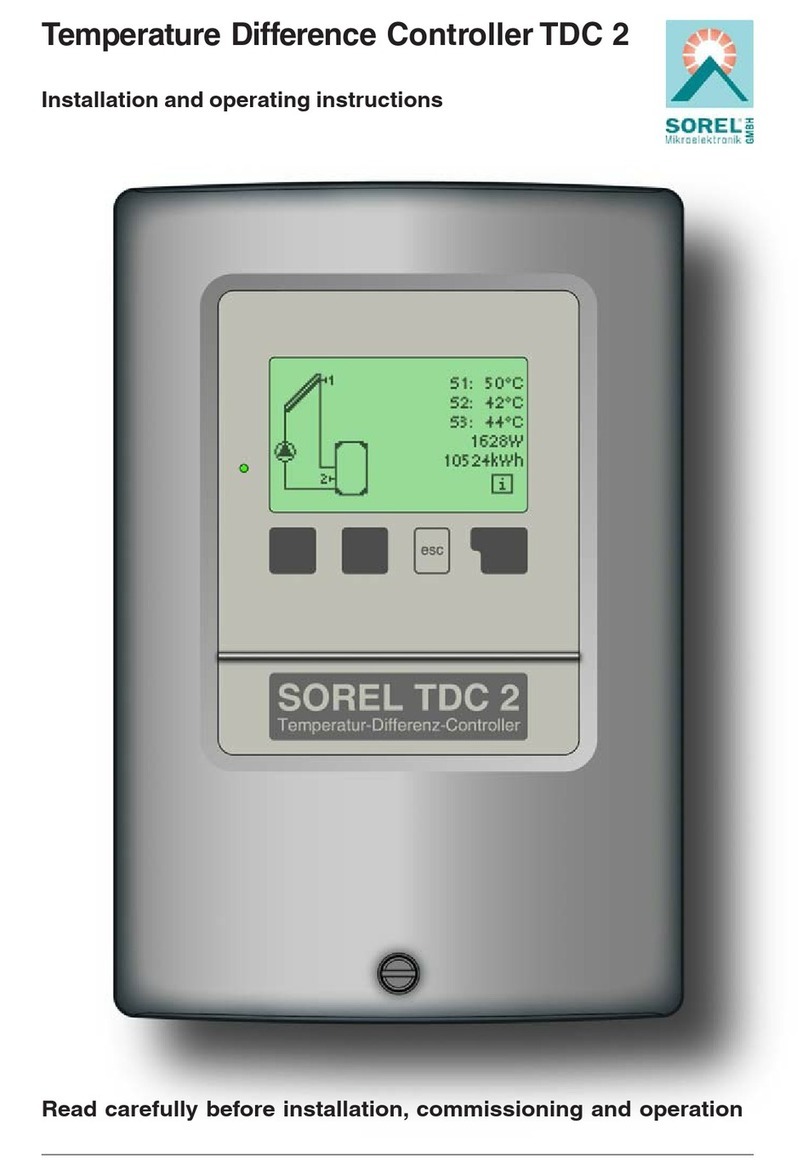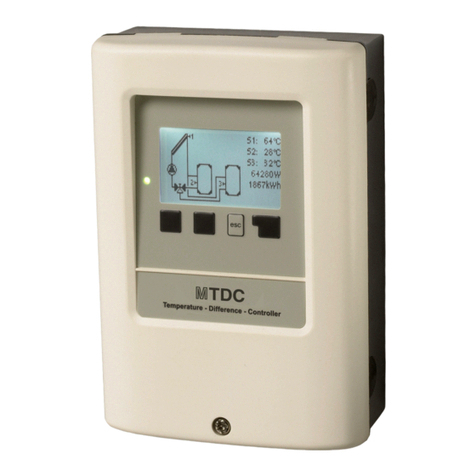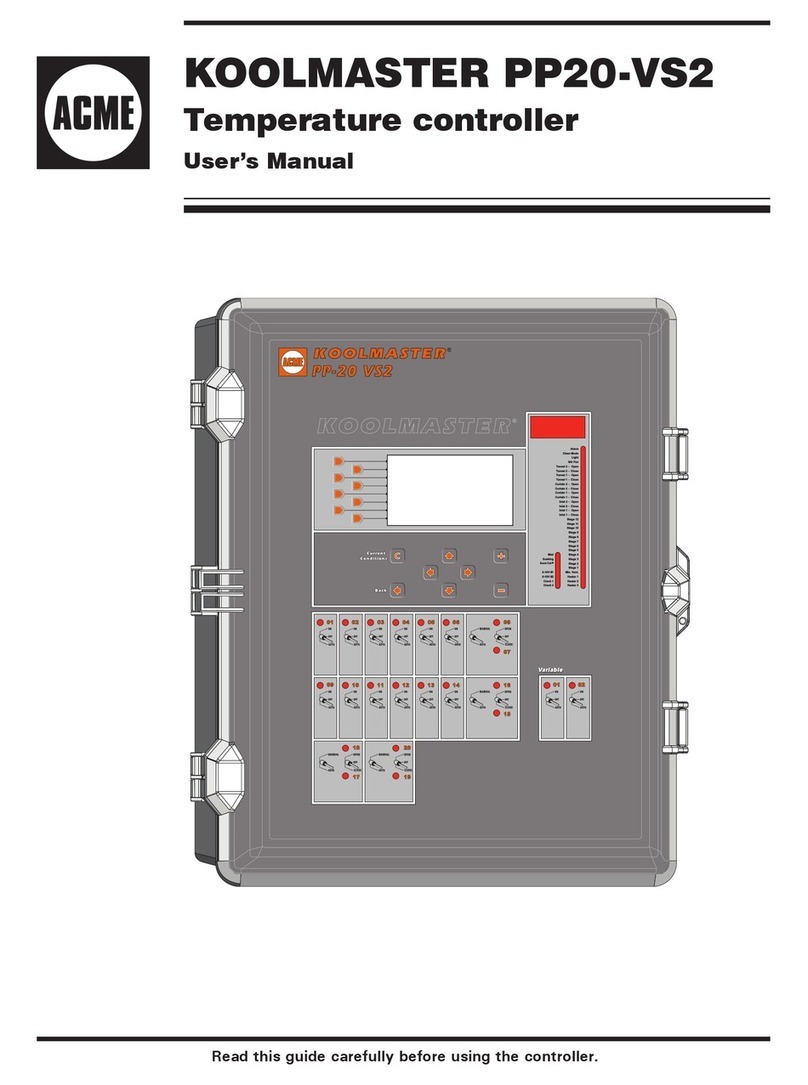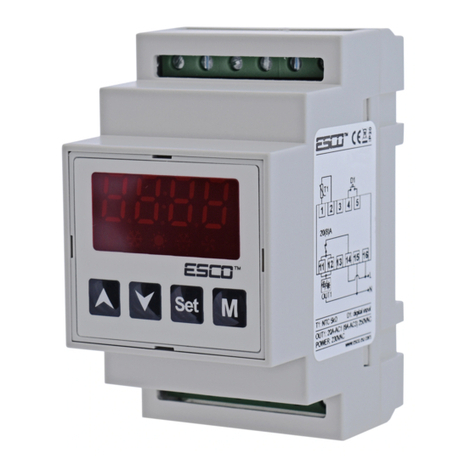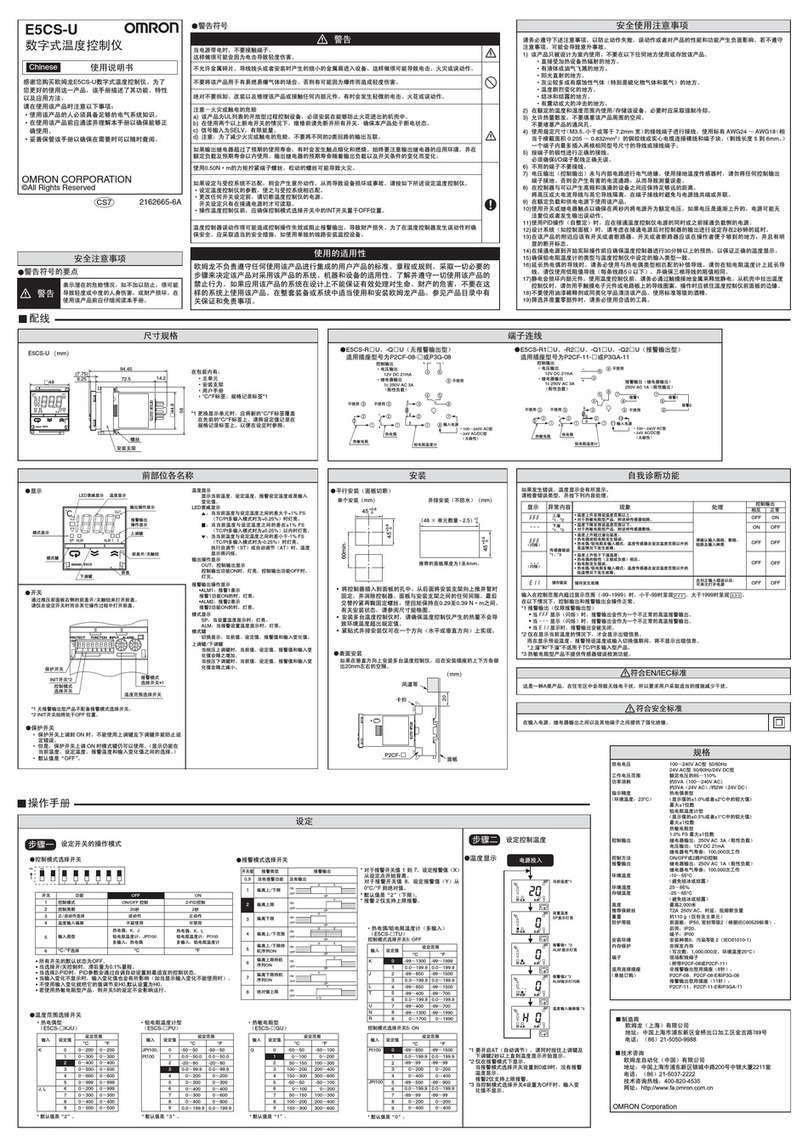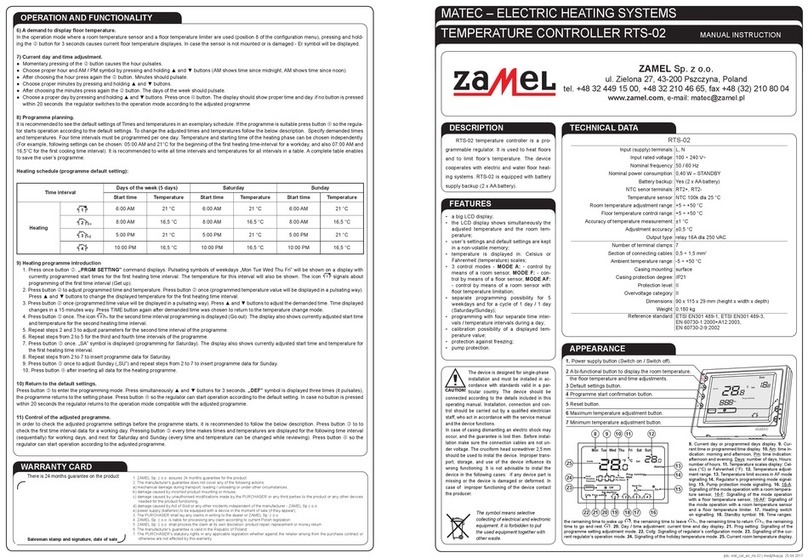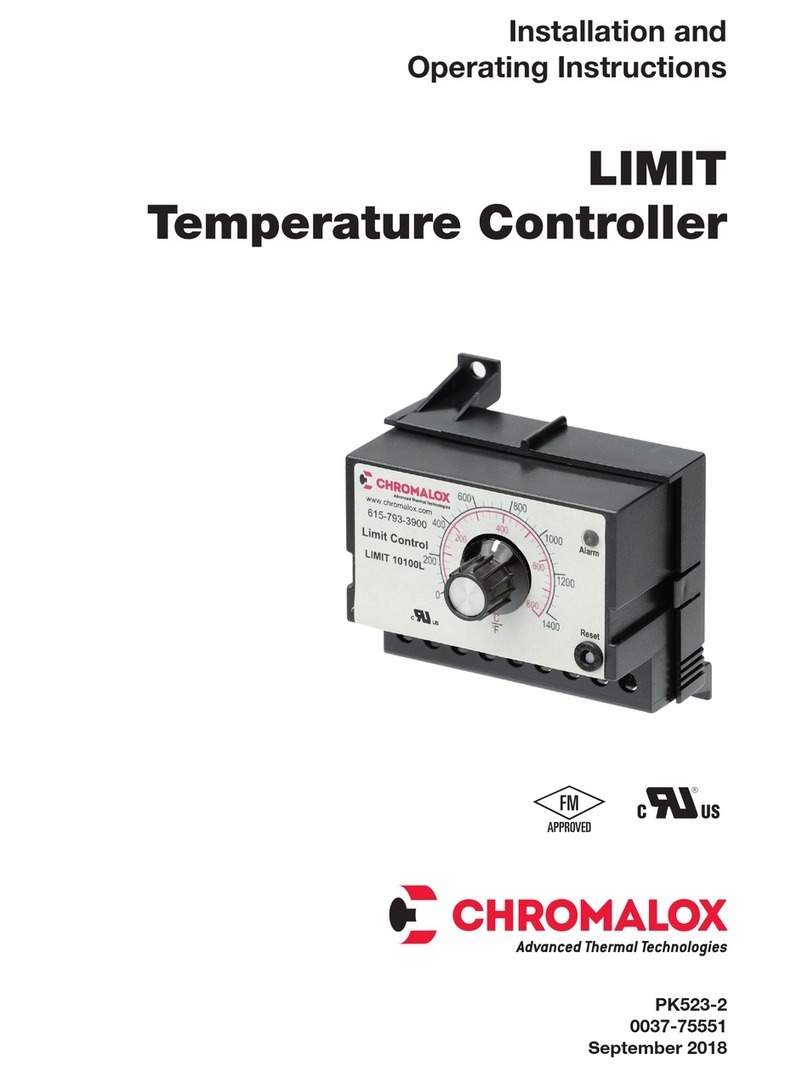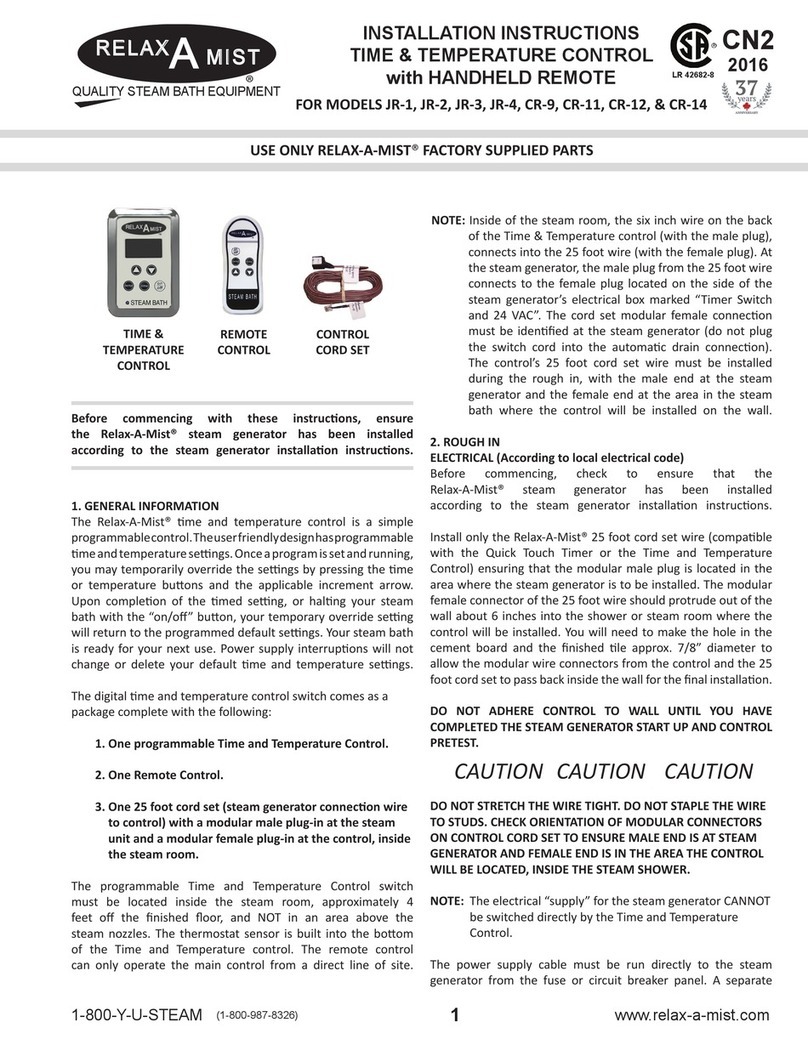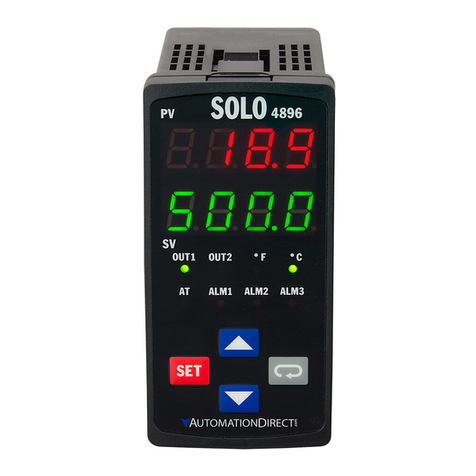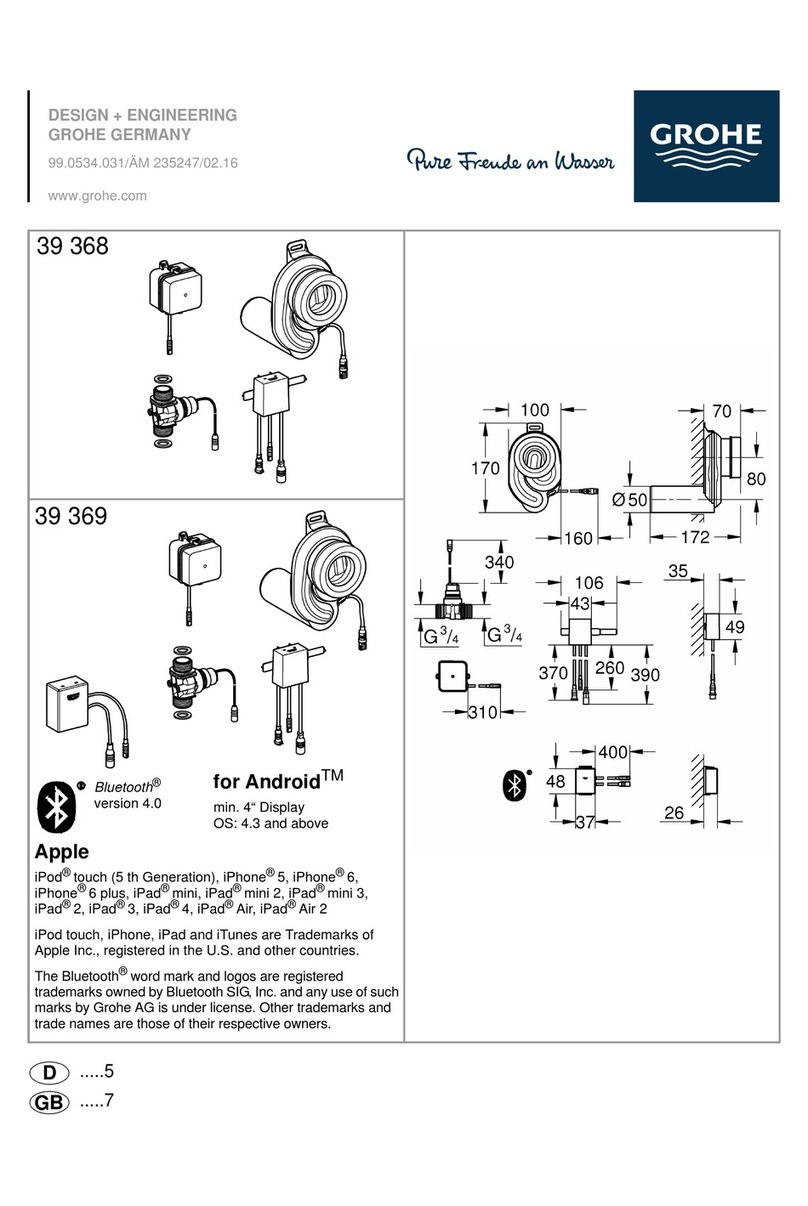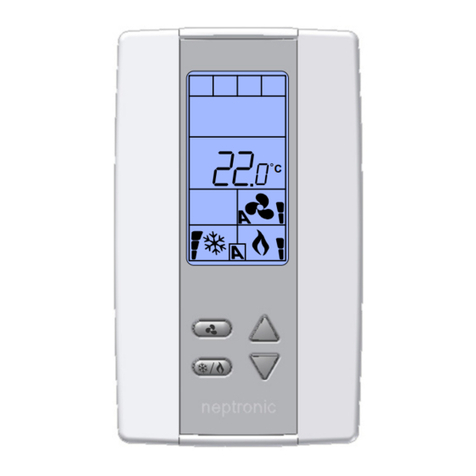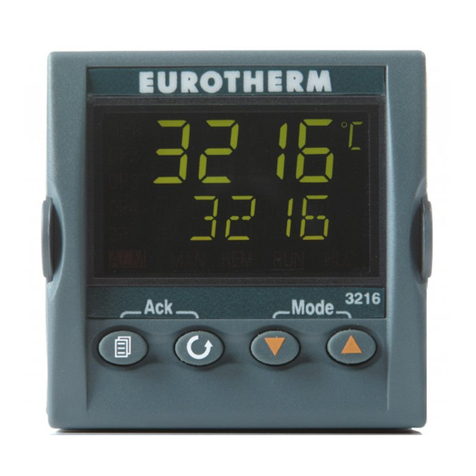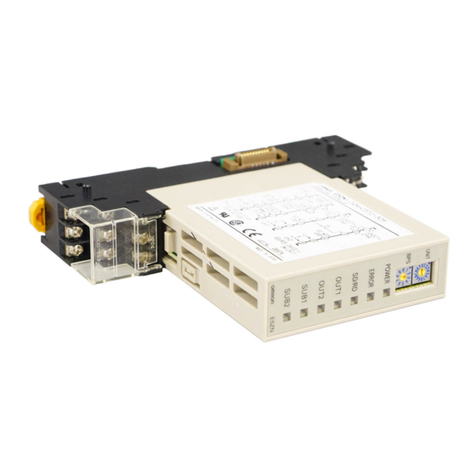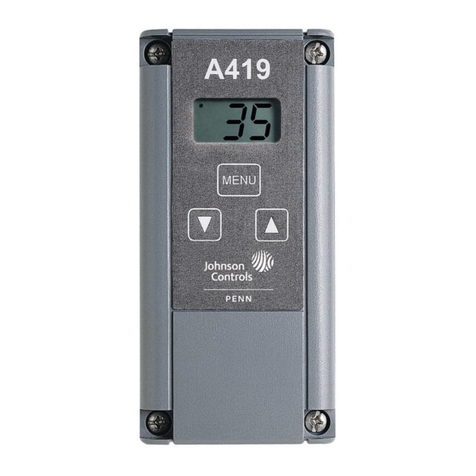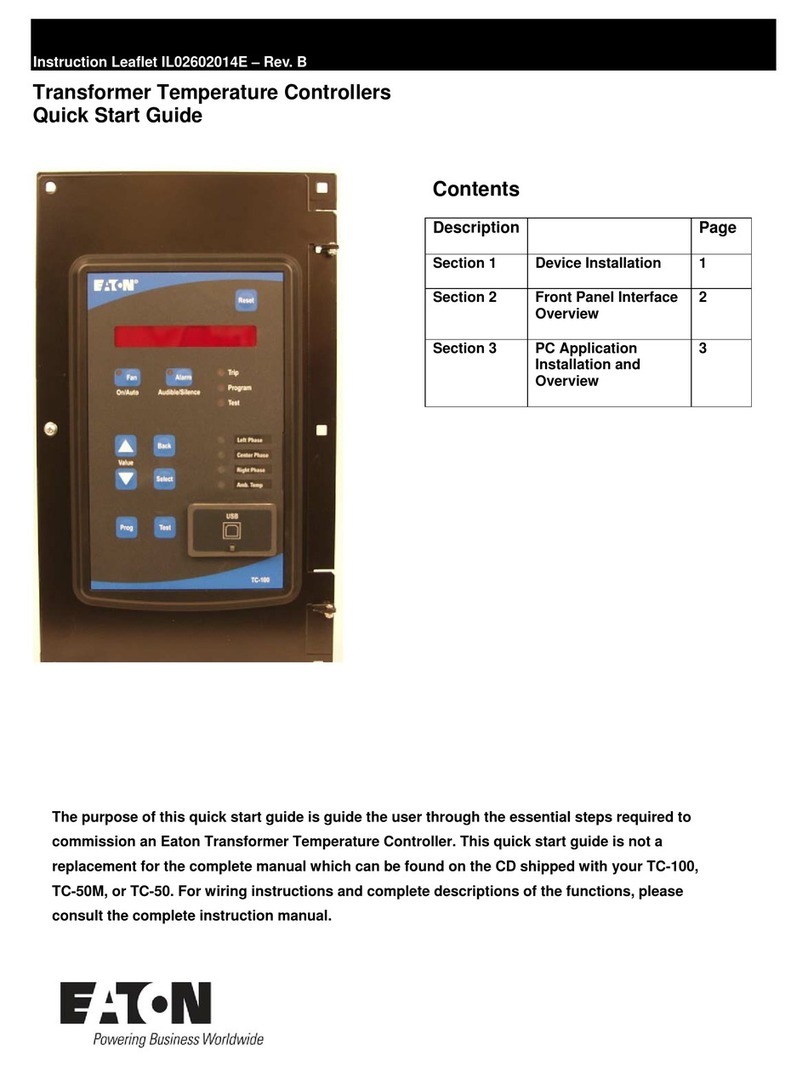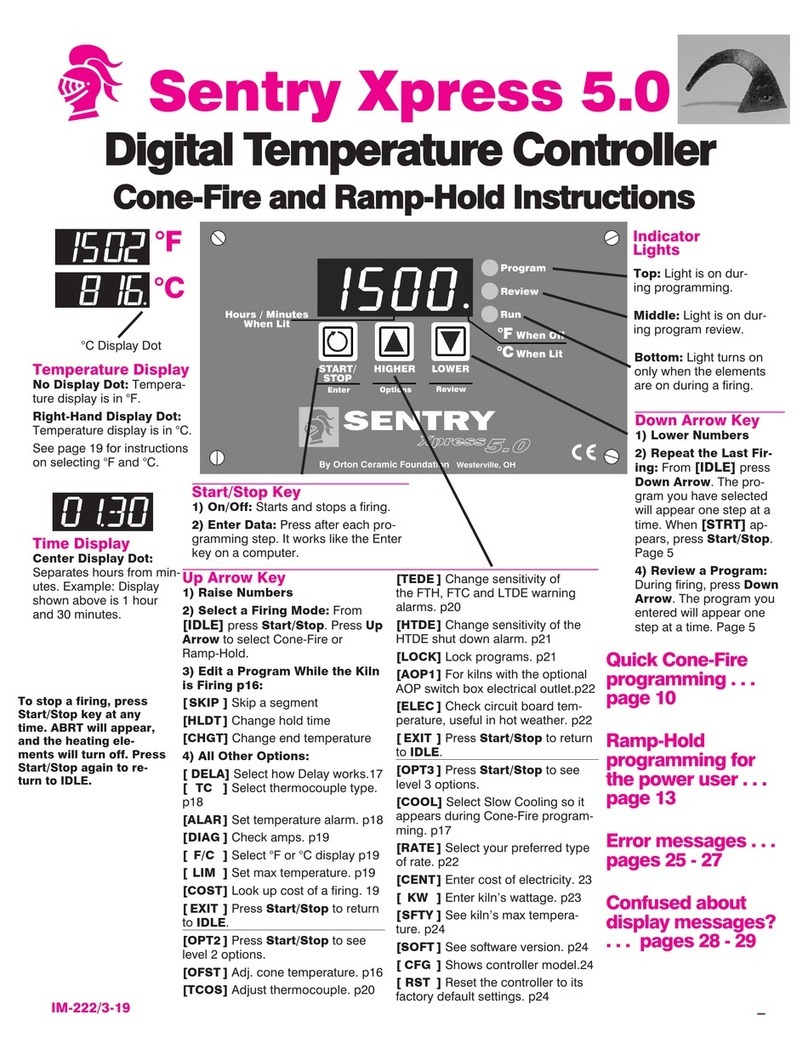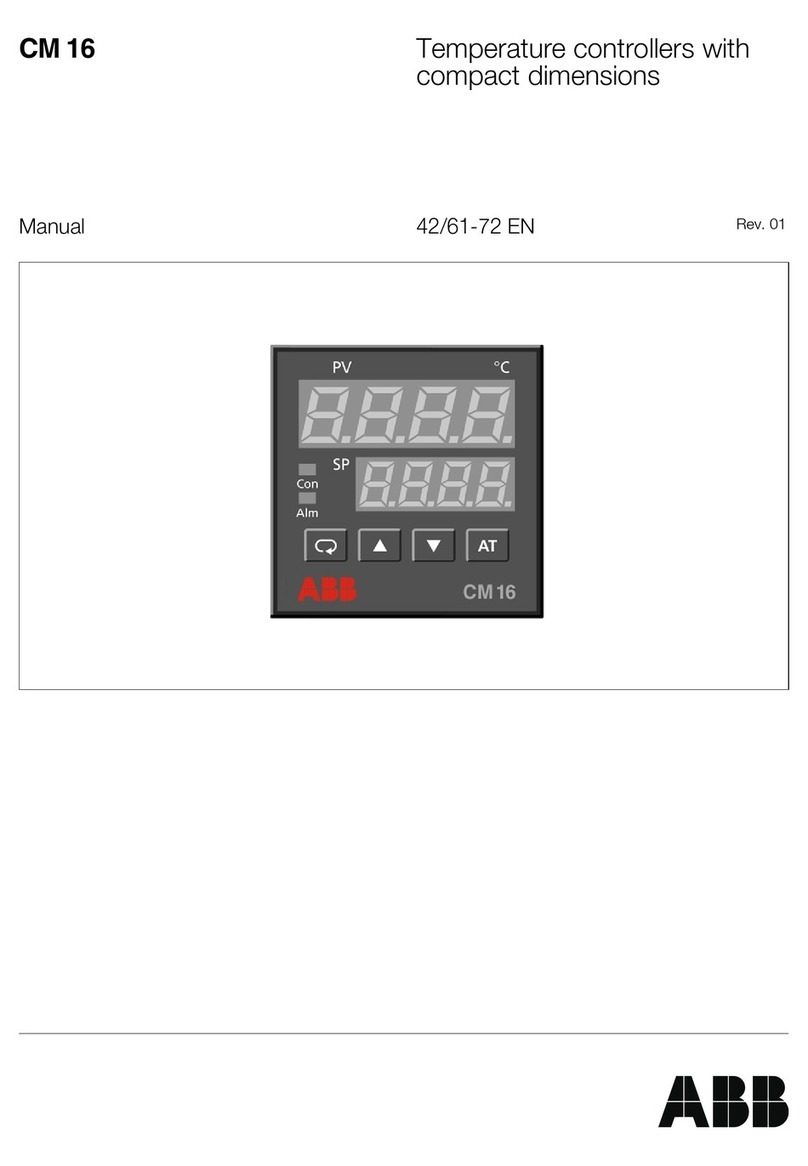Sorel STDC User manual

Temperature difference controller STDC
Installation and operating instructions
applies to STDC version 1 - 4
Read carefully before installation, commissioning and operation

CONTENT
Safety Instructions 4
EU-Conformity 4
General Instructions 4
Explanation of Symbols 4
Changes to the Unit 5
Warranty and Liability 5
Disposal and Pollutants 5
Description STDC 5
About the Controller 5
Technical Data 6
Scope of Supply 6
Hydraulic Variants 7
Installation 8
Electrical Terminals 8
Electrical Terminals 9
wall Installation 11
Electrical Connection 12
Installing the Temperature Sensors 13
Temperature Resistance Table for Pt1000 Sensors 13
Operation 13
Display and Input 13
Commissioning help 14
1. Measurement values 14
2. Statistics 15
Operating hours 15
Avarage ΔT 15
Heat quantity 15
Graphic overview 15
Message Log 15
Reset / Clear 15
3. Display mode 16
Schematic 16
Overview 16
Alternating 16
Eco Display Mode 16
4. Operating Mode 17
Auto 17
Manual 17
Aus 17
5. Settings 18
Tmin S1 18
Tmin S2 18
ΔT R1 18
Tset On 18
Tmax S1 18
Thermostat periods 19
Tmin Storage X 19
6. Protective Functions 20
Seizing Protection 20
Frost Protection 20
System protection 20
Collector protection 20
Collector alarm 20
Recooling 20
Anti-Legionella 21
7. Special Functions 22
Program selection 22
Signal 22
Signal type 22
Output Signal 22
PWM / 0-10V off 22
PWM / 0-10V on 22
PWM / 0-10V max. 22
Show signal 22
Speed control 23
Variant 23
Purging time 23
Sweep time 23
Max. Speed 23
Min. Speed 23
Setpoint 23
Time & Date 23
Sensor Calibration 24
Commissioning 24
Factory settings 24
Heat quantity 24
Starting aid 24
Purging time 25
Increase 25
Daylight saving time 25
8. Menu Lock 26
9. Service Values 26
10. Language 26
Malfunctions/Maintenance 27
Final Declaration 28
2

This manual applies to the following different hardware versions.
STDC Version 1
3 temperature sensor inputs
1 relay output 230 AC (on/off)
STDC Version 2
3 temperature sensor inputs
1 electronic relay output 230 AC (for speed control of standard pumps)
STDC Version 3
3 temperature sensor inputs
1 relay output 230 AC (on/off)
1 PWM/0-10V output (for speed control of high effi ciency pumps)
STDC Version 4
3 temperature sensor inputs
1 electronic relay output 230 AC (for speed control of standard pumps)
1 PWM/0-10V output (for speed control of high effi ciency pumps)
If the version is not visible there, please go to the menu "Service values" in the controller. In the first line you can read the ver-
sion.
3

Safety Instructions
EU-Conformity
By affixing the CE mark to the unit the manufacturer declares that theSTDC conforms to the following relevant safety regulations:
lEU low voltage directive 2014/35/EU
lEU electromagnetic compatibility directive 2014/30/EU
conforms. Conformity has been verified and the corresponding documentation and the EU declaration of conformity are kept on file by
the manufacturer.
General Instructions
Please read carefully!
These installation and operating instructions contain basic instructions and important information regarding safety, installation, com-
missioning, maintenance and the optimal use of the unit. Therefore these instructions must be read and understood completely by the
installation technician/specialist and by the system user before installation, commissioning and operation of the unit.
This unit is an automatic, electrical Temperature difference controller for/insolar or heating system and similar applications. Install the
unit only in dry areas and under the ambient conditions described in “Specifications”.
The valid accident prevention regulations, VDE regulations, the regulations of the local power utility, the applicable DIN-EN standards
and the installation and operating instruction of the additional system components must also be observed.
Under no circumstances does the unit replace any safety devices to be provided by the customer!
Installation, electrical connection, commissioning and maintenance of the device may only be carried out by an appropriately trained
specialist. Users: Make sure that the specialist gives you detailed information on the function and operation of the unit. Always keep
these instructions in the vicinity of the unit.
The manufacturer does not take over any liability for damage caused through improper usage or non-compliance of this manual!
Explanation of Symbols
Danger
Failure to observe these instructions can result in electrocution.
Danger
Failure to observe these instructions can result in serious damage to health such as scalding or life-threatening injur-
ies.
Caution
Failure to observe these instructions can result in destruction of the unit or the system, or environmental damage.
Caution
Information which is especially importation for the function and optimal use of the unit and the system.
4

Changes to the Unit
lChanges, additions to or conversion of the unit are not permitted without written permission from the manufacturer.
lIt is likewise forbidden to install additional components that have not been tested together with the unit.
lIf it becomes clear that safe operation of the unit is no longer possible, for example because of damage to the housing, turn the
Unit off immediately.
lAny parts of the unit or accessories that are not in perfect condition must be exchanged immediately.
lUse only original spare parts and accessories from the manufacturer.
lMarkings made on the unit at the factory must not be altered, removed or made illegible.
lOnly the settings described in these instructions may be set using the Unit.
Changes to the unit can compromise the safety and function of the unit or the entire system.
Warranty and Liability
The unit has been manufactured and tested with regard to high quality and safety requirements. The unit is subject to the statutory
guarantee period of two years from the date of sale. The warranty and liability shall not include, however, any injury to persons or
material damage that is attributable to one or more of the following causes:
lFailure to observe these installation and operating instructions.
lImproper installation, commissioning, maintenance and operation.
lImproperly executed repairs.
lUnauthorised structural changes to the unit.
lUse of the device for other than its intended purpose.
lOperation above or below the limit values listed in the ‚Specifi cations‘ section.
lForce majeure.
Disposal and Pollutants
The unit conforms to the European RoHS 2011/65/EU for the restriction of the use of certain hazardous substances in electrical and
electronic equipment.
Under no circumstances may the device be disposed of with the normal household waste. Dispose of the unit only at appro-
priate collection points or ship it back to the seller or manufacturer.
Description STDC
About the Controller
The Temperature difference controller STDC facilitates efficient use and function control of your solar or heating system possible while
its handling is intuitive. After every input step the suitable functions are matched to the keys and explained in a text above. In the menu
'measurement values and settings' are help text and graphics in addition to key words.
The STDC can be used for the various system variants. " Hydraulic Variants " on page 7
Important characteristics of the STDC are:
lDepiction of graphics and texts using a lit display.
lSimple viewing of the current measurement values.
lStatistics and system monitoring by means of statistical graphics
lExtensive setting menus with explanations.
lMenu block can be activated to prevent unintentional setting changes.
lResetting to previously selected values or factory settings.
5

Technical Data
Electrical specifications:
Power Supply 230VAC +/- 10%, 50 - 60 Hz
Power consumption / standby 1,5W - 2W/ 0,5 W
Internal fuse 1 1
Protection Class IP40
Protection Class II
Overvoltage category II
Degree of pollution category II
Inputs/Outputs
Version 1 Version 2 Version 3 Version 4
Pt1000 Measuring range -40 °C ... 300 °C 3 3 3 3
mechanical relay as alternating contact (R)
460VA for AC1 / 460W for AC3
1 - 1 -
mechanical relay 230V 2 1 2 -
electronic relay min. 5W ... max. 120W for AC3 - 1 - 1
0-10V output (Tolerance +/- 10%) 10 kΩ load - - V1 V1
PWM output freq. 1 kHz, level 10 V - - V1 V1
Max. Cable Length
Collector sensor S1 < 30 m
Storage sensor S2 and S3 < 10 m
0-10V/PWM < 3 m
mechanical relay < 10 m
electronic relay <3m
Permissible Ambient Conditions
for controller operation 0 °C - 40 °C, max. 85 % rel. humidity at 25 °C
for transport/storage 0 °C - 60 °C, no moisture condensation permitted
Other Specifications and Dimensions
Housing Design 2-part, ABS plastic
Installation Methods Wall installation, optionally panel installation
Overall dimensions 115 mm x 86 mm x 45 mm
Aperture installation dimen-
sions
108 mm x 82 mm x 25,2 mm
Display Fully graphical display, 128 x 64 dots
Real Time Clock RTC with 24 hour power reserve
Operation 4 entry keys
Scope of Supply
lSingle circuit solar controller STDC
l4 strain relief clips with 8 screws, replacement fuse 2AT
l2 screws 3,5 x 35 mm and 2 plugs 6 mm for wall installation.
lSTDC installation and operating instructions
6

Hydraulic Variants
The following illustrations should be regarded only as schematic representations of the respective hydraulic systems and do not claim to be complete. Under no circumstances should the controller
replace any safety devices. Depending on the specific application, additional system and safety components such as check valves, non-return valves, safety temperature limiters, scalding protectors,
etc., may be required.
For 3-way valves, the flow direction in energized state (relay active) is shown in the used hydraulic version.
Solar with reservoir Solar with pool Solid fuel boiler with storage
Storage transfer Heating circuit return flow increase Thermostat
Universal Delta T Shutoff valve Solar with pool and heat exchanger 1
7

Installation
Electrical Terminals
Mains voltages
230 VAC 50 - 60 Hz
Low voltages
max. 12 VAC / DC
Terminal: Connection for:
L Network outer conductor L
N Network neutral conductor N
R Relay 3 closer
N Neutral conductor N Relay
R Relay opener
Terminal: Connection for:
S1 Temperature Sensor 1
S2 Temperature Sensor 2
S3 Temperature Sensor 3
V1 0-10V / PWM output for speed controlled HE-
pumps
- GND V1
The PE protective conductor must be connected to the PE metal
terminal block!
"Connection of PWM pumps"
PWM pumps are connected to the controller with 2 wires 1)
PWM Input (default: brown) 2) GND (default: blue). Some
pumps have a third wire (PWM Output Signal (default: black)).
This is not used for the connection!
The matching terminal assignment to your system or hydraulic diagram, see the descriptions in the respective hydraulic
diagram," Hydraulic Variants " on page 7.
8

Electrical Terminals
For high-efficiency pumps with 0-10V / PWM signal input, the power can be provided (V1 parallel operation) over a free
relay.
Program 2 Solar with pool
Mains voltages
230VAC 50-60Hz
Low Voltage
max. 12VAC/DC
Terminal: Connection: Terminal: Connection:
L Network outer conductor L S1 (2x) Sensor 1 collector
N Network neutral conductor N S2 (2x) Sensor 2 Pool
R Pump outer conductor L S3 (2x) Sensor 3 (optional)
N Pump neutral conductor N The polarity of the sensors S1-S3 is freely
selectable.
R| Break contact (STDC Version
1+3)
V1 0-10V/ PWM +/- ( STDC Version
3+4 )
- GND V1
Program 3 Solid fuel with storage tank
Mains voltages
230VAC 50-60Hz
Low Voltage
max. 12VAC/DC
Terminal: Connection: Terminal: Connection:
L Network outer conductor L S1 (2x) Sensor 1 solid fuel boiler
N Network neutral conductor N S2 (2x) Sensor 2 storage
R Pump outer conductor L S3 (2x) Sensor 3 (optional)
N Pump neutral conductor N The polarity of the sensors S1-S3 is freely
selectable.
R| Break contact (STDC Version
1+3)
V1 0-10V/ PWM +/- ( STDC Version
3+4 )
- GND V1
Program 4 Storage transfer
Mains voltages
230VAC 50-60Hz
Low Voltage
max. 12VAC/DC
Terminal: Connection: Terminal: Connection:
L Network outer conductor L S1 (2x) Sensor 1 storage 1
N Network neutral conductor N S2 (2x) Senaor 2 storage 2
R Pump outer conductor L S3 (2x) Sensor 3 (optional)
N Pump neutral conductor N The polarity of the sensors S1-S3 is freely
selectable. N
R| Break contact (STDC Ver-
sion 1+3)
V1 0-10V/ PWM +/- ( STDC Version
3+4 )
- GND V1
9

Program 5 Raising of heat circuit
Mains voltages
230VAC 50-60Hz
Low Voltage
max. 12VAC/DC
Terminal: Connection: Terminal: Connection:
L Network outer conductor L S1 (2x) Sensor 1 storage 1
N Network neutral conductor N S2 (2x) Sensor 2 Return flow
R Valve outer conductor L S3 (2x) Sensor 3 (optional)
N Valve neutral conductor N The polarity of the sensors S1-S3 is freely
selectable. N
R| Break contact (STDC Version
1+3)
V1 0-10V/ PWM +/- ( STDC Version
3+4 )
- GND V1
Actuating direction of valve:
R1 on/valve on = direction through the storage tank
Program 6 thermostat
Mains voltages
230VAC 50-60Hz
Low Voltage
max. 12VAC/DC
Terminal: Connection: Terminal: Connection:
L Network outer conductor L S1 (2x) Sensor 1 storage top
N Network neutral conductor N S2 (2x) Sensor 2 (optional)
R Pump outer conductor L S3 (2x) Sensor 3 (optional)
N Pump neutral conductor N The polarity of the sensors S1-S3 is freely
selectable.
R| Break contact (STDC Version
1+3)
V1 0-10V/ PWM +/- ( STDC Version
3+4 )
- GND V1
Program 7 Universal ΔT controller
Mains voltages
230VAC 50-60Hz
Low Voltage
max. 12VAC/DC
Terminal: Connection: Terminal: Connection:
L Network outer conductor L S1 (2x) Sensor 1 control
N Network neutral conductor N S2 (2x) Probe 2 reference
R Pump outer conductor L S3 (2x) Sensor 3 (optional)
N Pump neutral conductor N The polarity of the sensors S1-S3 is freely
selectable.
R| Break contact (STDC Version
1+3)
V1 0-10V/ PWM +/- ( STDC Version
3+4 )
- GND V1
Program 8 Shutoff valve
Mains voltages
230VAC 50-60Hz
Low Voltage
max. 12VAC/DC
Terminal: Connection: Terminal: Connection:
L Network outer conductor L S1 (2x) Sensor 1 flow
N Network neutral conductor N S2 (2x) Sensor 2 storage
R Shutoff valve outer conductor
L
S3 (2x) Sensor 3 (optional)
N Stop valve neutral conductor
N
The polarity of the sensors S1-S3 is freely
selectable.
R| Break contact (STDC Ver-
sion 1+3)
V1 0-10V/ PWM +/- ( STDC Version
3+4 )
- GND V1
10

Program 9 Solar with heat exchanger and pool
Mains voltages
230VAC 50-60Hz
Low Voltage
max. 12VAC/DC
Terminal: Connection: Terminal: Connection:
L Network outer conductor L S1 (2x) Sensor 1 collector
N Network neutral conductor N S2 (2x) Sensor 2 pool
R Pump outer conductor L S3 (2x) Sensor 3 secondary circuit
N Pump neutral conductor N The polarity of the sensors S1-S3 is freely
selectable.
R| Break contact (STDC Ver-
sion 1+3)
V1 0-10V/ PWM +/- ( STDC Version
3+4 )
- GND V1
Both pumps are connected to the same relay.
wall Installation
1. Unscrew cover screw completely.
2. Carefully pull upper part of housing from lower part.
3. Set upper part of housing aside. Do not touch the electronics.
4. Hold the lower part of the housing up to the selected position
and mark the two mounting holes. Make sure that the wall sur-
face is as even as possible so that the housing does not
become distorted when screwed on.
5. Using a drill and size 6 bit, drill three holes at the points
marked on the wall and push in the plugs. Optionally the hous-
ing can be mount with 4 mounting holes.
6. Insert the upper screw and screw it in lightly.
7. Fit the upper part of the housing and insert the other two
screws.
8. Align the housing and tighten the three screws.
If problems occur with the operation of the terminals, our video on our YouTube page can help you:
http://www.sorel.de/youtube
11

Electrical Connection
Before working on the unit, switch off the power supply and secure it against being switched on again! Check that there is no
power flowing! Electrical connections may only be made by a specialist and in compliance with the applicable regulations.
The unit may not be put into operation if there is visible damage to the housing, e.g. cracks.
The unit may not be accessible from behind.
Low-voltage cables such as temperature sensor cables must be routed separately from mains voltage cables. Feed tem-
perature sensor cables only into the left-hand side of the unit, and mains voltage cables only into the right-hand side.
The customer must provide an all-pole disconnecting device, e.g. an emergency heating switch.
The cables being connected to the unit must not be stripped by more than 55 mm, and the cable jacket must reach into the
housing just to the other side of the strain relief.
Fig. 1
1. Select required program/ hydraulic variants.
2. Strip cables by 55 mm max., (fig.1) strip the last 9-10 mm of the wires.
3. Open controller housing (" wall Installation " on page 11).
Fig. 2
4. Install PE terminal block (Fig.2)
5. Connect the supplied connection terminals " Electrical Terminals " on page 8.
When using fine-stranded cables with a screwdriver, press the orange handles.
(Fig. 3)
For single-wire cables or cables equipped with wire-end ferrules, simply insert the
cable. (Fig. 3.1.).
6. Insert the connecting terminals into the appropriate pin strips.
Fig. 3 | Fig. 3.1
7. Mount strain reliefs.
8. Hang on the upper housing part and close the housing with gentle pressure
9. Cover screw tighten.
10. Turn on mains supply and operate the controller.
12

Installing the Temperature Sensors
The controller operates with Pt1000 temperature sensors which are accurate to 1 °C, ensuring optimal control of system functions.
If desired, the sensor cables can be extended to a maximum of 30 m using a cable with a cross-section of at least 0.75
mm². Ensure there is no contact resistance! Position the sensor precisely in the area to be measured! Only use immersion,
pipe-mounted or flat-mounted sensors suitable for the specific area of application with the appropriate permissible tem-
perature range.
Low-voltage cables such as temperature sensor cables must be routed separately from mains voltage cables. Feed tem-
perature sensor cables only into the left-hand side of the unit, and mains voltage cables only into the right-hand side.
Temperature Resistance Table for Pt1000 Sensors
°C -20 -10 0 10 20 30 40 50 60 70 80 90 100
Ω 922 961 1000 1039 1077 1116 1155 1194 1232 1270 1308 1347 1385
Operation
Display and Input
Pump (rotates when active)
Valve (direction of flow black)
Collector
Storage / buffer
Solid fuel boiler
Pool
Thermostat On/Off
Temperature Sensors
Further symbols can be found in the special functions
Examples for key settings:
+/- Increase / decrease values
▼/▲ Scroll menu down / up
Yes/No agree / reject
About further information
Back to the previous display
Ok Confirm selection
Confirm Confirm setting
The display‘s (1), extensive text and graphical mode, enables
simple, almost self-explanatory, operation of the controller.
The function of the other 3 keys (4) is shown in the display right
above the keys. The right-hand key generally has a confirmation
and selection function.
The graphics mode appears if not key is pressed for 2 minutes or
after exiting the main menu with ‘esc’.
Hitting the "esc" key in the graphics mode takes you directly to
the main menu.
13

Commissioning help
1. Set language and time
2. Commissioning help / setup wizard
a) select or
b) skip.
The setup wizard guides through the necessary basic settings in the correct
order. Every parameter is explained on the display of the controller. Pressing the
“esc” key takes you back to the previous setting.
b) With free commissioning the settings should be made in the following order:
lmenu 10. Language
lmenu 3. Time, Date and Operating Times.
lMenu 5. Settings, all values
lmenu 6. Protection Functions (if any adjustments necessary).
lmenu 7. Special Functions (if any adjustments necessary).
3. In menu operating mode "4.2. Manual" "4.1. Manual”, test the witch outputs
with the consumers connected and check the sensor values for plausibility. Then
set to automatic mode. " Manual " on page 17
The setup wizard can be accessed in menu 7.6 at any time.
Consider the explanations for the individual parameters on the following pages and check if further settings are necessary
for your application.
1. Measurement values
Serve to display the current measured temperatures.
If ‚error‘ appears on the display instead of the measurement value,
there may be a defective or incorrect temperature sensor.
If the cables are too long or the sensors are not well-placed, small
deviations in the measurement values may occur. In this case, the dis-
play values can be compensated by adjustments in the controller "
Sensor Calibration " on page 24. The selected program, connected
sensors and the specific model design determine which measurement
values are displayed.
14

2. Statistics
Serve for function control and long-term monitoring of the system.
For time-dependent functions such as circulation and anti-legionella
and the evaluation of system data, it is essential that the time is accur-
ately set on the controller. Please note that the clock continues to run
for about 24 hours if the mains voltage is interrupted, and afterward
must be reset. Improper operation or an incorrect time may result in
data being cleared, recorded incorrectly or overwritten. The man-
ufacturer accepts no liability for the recorded data!
Operating hours
Display of the operating hours of the consumers connected to the controller (for example, solar pumps, valves etc.) whereby different
time ranges (day-years) are available!
Avarage ΔT
Display of the average temperature difference between the reference sensors when the switched on consumers.
Heat quantity
Display of the consumed heat quantity form the system in kWh.
This is an indicative value.
Graphic overview
This results in a clear illustration of the data as a bar graph. Different time ranges are available for comparison. You can page through
with the two left keys.
Message Log
Display of the last 20 errors in the system with indication of date and time.
Reset / Clear
Resetting and clearing the selected statistics. Selecting ‚all statistics‘ clears everything except the messages.
15

3. Display mode
Used to define the controller’s display for normal operation. This display appears
whenever two minutes go by without any key being pressed. The main menu
appears again when a key is pressed. The menu is closed by pressing “esc” or
selecting “Exit display mode”.
Schematic
In the graphics mode, the selected hydraulic systems are displayed with the measured temperatures and operating states of the con-
nected consumers.
Overview
In the overview mode, the measured temperatures and operating states of the connected consumers are displayed in text form.
Alternating
In alternating mode the schematic mode and then the overview mode are active for 5 seconds.
Eco Display Mode
In Eco Display Mode the backlight of the display is switched off if no buttons are pushed for 2 minutes.
If a message exists, the backlight does not switch off until the message has been scanned by the user.
16

4. Operating Mode
Auto
The automatic mode is the normal mode of the controller. A correct controller function under consideration of the current temperatures
and the set parameters is only present in automatic mode! After an interruption of the mains voltage, the controller automatically
returns to the last operating mode selected.
Manual
The individual relay outputs, v outputs and the connected consumers can be checked for proper functioning and correct assignment.
The operating mode ‚Manual‘ may only be used by specialists for brief function tests, e.g. during commissioning! Function in
manual mode: The relays and thus the connected consumers are switched on and off by pressing a key, with no regard to
the current temperatures and set parameters. At the same time, the current measurement values of temperature sensors are
also shown in the display for the purposes of function control.
Aus
If the operating mode “off” is enabled, all control functions are turned off. The measured temperatures are displayed for the
overview.
17

5. Settings
By no means does the controller replace the safety appliances on site!
Tmin S1
Enable/start temperature at sensor 1:
If this value on the sensor 1 (collector sensor) is exceeded and the other conditions are not fulfilled, the controller will turn on the affil-
iated pump or the valve. If the temperature on the sensor 1 falls 5 °C below this value, the pump or the valve will be turned off again.
Tmin S2
Switch off temperature at sensor 2:
If this value is exceeded on the sensor 2, the controller turn off the affiliated pump or the valve. If this value on the sensor 2 is undershot
and the other conditions are fulfilled, the controller will turn on the pump or the valve.
Temperature values which are set too high can lead to scalding or damage to the system. Scalding protection must be
provided by the customer!
In multiple storage systems, if the shut-down temperature S2 is exceeded, a downstream installed storage or storage area is switched
to.
ΔT R1
On/off temperature difference for solar charge through relay R1:
If the temperature difference ΔT Solar between the reference sensors S1 and S2 is exceeded and the other conditions are fulfilled, the
controller will turn on the pump on the relay R1. If the temperature difference falls to ΔT Off, the pump will be turned off.
If the set temperature difference is too small, this may lead to ineffective operation depending on the system and sensor pos-
itioning. For speed regulation (" Speed control " on page 23), special switch conditions apply!
Tset On
Reference temperature sensor 1
Heating mode = 1. Value smaller than 2. value,
Cooling mod = 1. Value bigger than 2. value.
If the set switch-on value (1. Value) at sensor 1 undershot and thermostat function is approved (see also 5.5), backup heating is
switched on until temperature exceeds value for switch off (2. Value).
Temperature values which are set too high can lead to scalding or damage to the system. Scalding protection must be
provided by the customer!
If sensor S2 is connected, S1 functions as a switch-on sensor and S2 as a switch-off sensor.
Tmax S1
Switch off temperature at sensor 1
If this value is exceeded on the sensor 1, the controller turn off the affiliated pump or the valve. If sensor 1 falls below this value again
and the other conditions are also met, then the controller switches the pump and/or valve on again.
18

Temperature values which are set too high can lead to scalding or damage to the system. Scalding protection must be
provided by the customer!
Thermostat periods
Here the desired periods are set in which the thermostat function is approved. For each weekday, three times can be specified, fur-
thermore, you can copy individual day to other days. The thermostat function is shut down outside of the set times.
Tmin Storage X
Switch off temperature at sensor S(X)
If this value is exceeded at sensor X then the controller switches the associated pump and/or valve off. If sensor (X) falls below this
value again and the other conditions are also met, then the controller switches the pump and/or valve on again.
Temperature values which are set too high can lead to scalding or damage to the system. Scalding protection must be
provided by the customer!
19

6. Protective Functions
The 'Protective functions‘ can be used by specialists to activate and set various pro-
tective functions.
By no means does the controller replace the safety appliances on site!
Seizing Protection
If the anti-seizing protection is activated (daily, weekly, off), the controller switches the outputs on/off at 12:00 noon for 5 seconds to pre-
vent seizing of the pump/valve after long periods of inactivity.
Frost Protection
If the temperature at the outdoor sensor falls below 1 °C, the solar pump is switched on when frost protection is activated . If the outdoor
temperature rises above 1 °C again, the frost protection function is switched off.
Switching the frost protection function off or setting the minimum flow temperature too low can lead to severe damage to the
system.
System protection
Priority protection function
The system protection should prevent an overheating of the components installed in the system through the forced shut down of the
solar circulation pump. If the value “AS Ton” on the collector has been exceeded for 1 Min. the pump will be turned off and not turn on
again in order to protect the collector, for example, from steam. The pump will only be switched on again, when the collector temperature
falls below “SP Toff”.
With the system protection (on), there are increased standstill temperatures in the solar collector and therefore an increased
pressure in the system. The operating manuals from the system components must be observed.
Collector protection
Priority protection function
The collector protection prevents the collector from overheating. A forced switching of the pump makes sure that the collector is cooled
through the storage. If the value “KS Ton” is exceeded on the collector, the pump will be turned on in order to cool the collector. The
pump is shut down if the value “KS Toff” on the collector is not met or the value “KS Tmax Sp.” on the storage is exceeded.
System protection has priority over collector protection! Even if the switch requirements for the collector protection are present,
the solar circulation pump is turned off once “AS T on” is reached. Normally the values from the system protection (depending
on the maximum temperature of the storage or other components) are higher than the collector protection.
Collector alarm
If this temperature at the collector sensor is exceeded when the solar pump is turned on, a warning or error notification is triggered.
There is a corresponding warning in the display.
Recooling
In the system hydraulics with solar, excess energy is guided from the storage back to the collector with an activated return cooling func-
tion. This only occurs if the temperature in the storage is greater than the value “Return cooling Tref” and the collector is at least 20 °C
colder than the storage and until the storage temperature has fallen below the value “Return cooling Tref”. For muti-storage systems, the
return cooling applies to all storage.
20
Table of contents
Other Sorel Temperature Controllers manuals
